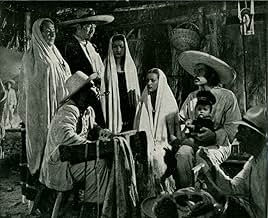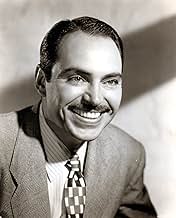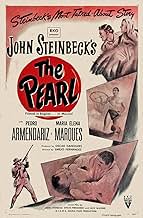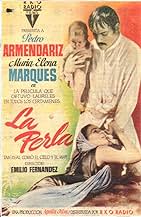NOTE IMDb
7,4/10
1,2 k
MA NOTE
La découverte d'une énorme perle change à jamais la vie d'un pauvre pêcheur mexicain et de sa famille. Mais la nouvelle se répand et éveille les convoitisesLa découverte d'une énorme perle change à jamais la vie d'un pauvre pêcheur mexicain et de sa famille. Mais la nouvelle se répand et éveille les convoitisesLa découverte d'une énorme perle change à jamais la vie d'un pauvre pêcheur mexicain et de sa famille. Mais la nouvelle se répand et éveille les convoitises
- Réalisation
- Scénario
- Casting principal
- Récompenses
- 9 victoires et 6 nominations au total
José Arratia
- Tratante de perlas
- (non crédité)
Guillermo Calles
- Indio rastreador
- (non crédité)
Enrique Cancino
- Pueblerino
- (non crédité)
Maria Elena Cuadros
- Juanita
- (non crédité)
Columba Domínguez
- Pueblerina
- (non crédité)
Enedina Díaz de León
- Yerbera
- (non crédité)
Agustín Fernández
- Pueblerino
- (non crédité)
Rogelio Fernández
- Pueblerino
- (non crédité)
Raquel García
- Pueblerina
- (non crédité)
Avis à la une
10whpratt1
Some how I over looked this John Steinbeck brief story years ago and loved this 1947 production and the fantastic acting. The film is great in black and white and it clearly shows the poverty of local fishermen and their hard tasks of having to dive only when the ocean was calm. Pedro Armendariz,"From Russia With Love",'63 and Maria Elena Marques,"Pueblilo",'62, gave an outstanding performance as husband and wife who have to deal with finding a great treasure and having to face the hard facts of many people who want to share their wealth. Charles Rooner,(Doctor),"Silent Fear",'56 plays a very horrible doctor who seems to hate the local fishermen and wants to treat only the rich who will be able to pay his medical fees. This is truly a great film, which was very well produced and a great Film Classic from the late 40's. Enjoy
Making an adaptation off John Steinbeck's short novel wasn't easy and always a feat.But Emilio Fernandez and Gabriel Figueroa did it in a succesful way.
Pedro Armendariz repeats on a high class of acting role as in 'Maria Candelaria'. Once again the cinematography of Gabriel Figueroa ranks among the best he's done. (the cinematography of this movie earned him, a prize at the Cannes Film Festival).
The aid of Mr. Steinbeck himself, helped Emilio to adapt the screenplay just as good as the novel itself.
This movie has no flaws and it ranks among the best in Mexico Film History, a must see.
Pedro Armendariz repeats on a high class of acting role as in 'Maria Candelaria'. Once again the cinematography of Gabriel Figueroa ranks among the best he's done. (the cinematography of this movie earned him, a prize at the Cannes Film Festival).
The aid of Mr. Steinbeck himself, helped Emilio to adapt the screenplay just as good as the novel itself.
This movie has no flaws and it ranks among the best in Mexico Film History, a must see.
What can go wrong when you gather several geniuses in their respective fields: California's John Steinbeck(who later won the Literature Nobel prize), Gabriel Figueroa, Mexico's greatest movies photographer, and one of the all time greats in international cinematography, Mexico's Emilio "Indio" Fernandez??? This movie is among Mexico's greatest movies of all times. It is a story of greed and poverty(which by the way could still be a contemporary story), it is an impacting story about a poor Fisherman whose son was denied treatment by the ambitious foreign Doctor in the Village, and who later tries to steal from the ignorant Fisherman, a very valuable pearl he found in the sea. This movie was produced for RKO Radio Pictures and it was released in both English and Spanish. As an added piece of information, El Indio Fernandez, the Director, who was in platonic love with Olivia de Havilland wanted her to be the star of the picture, but more than likely this was never offered to her; So much was the love that he had for Olivia, that the street where he lived in Mexico was named Dulce Olivia(sweet Olivia) at his request. This movie was filmed in 1945, precisely during the "Golden Age" of Mexico's Cinematography.
Apparently this piece is uncomfortable for people who simplify into moralism its complexity and forcefulness in what it has to say both explicitly and implicitly, aspirationism for wealth and the discord and greed it provokes, bourgeois class robbery of the working class, colonialist extractionism, whiteness as a jewel that gives privilege, all this as true then as it still is, set in a melodrama full of anguish, plus of course a beautiful montage in which the photography and the masterful underwater sequences stand out, marvellous at the time and which stand the test of time with great neatness.
The Pearl is directed by Emilio Fernández and John Steinbeck co-adapts his own novella of the same name with Fernández and Jack Wagner. It stars Pedro Armendariz, María Elena Marqués, Fernando Wagner, Gilberto González, Juan García and Charles Rooner. Music is by Antonio Díaz Conde and cinematography by Gabriel Figueroa.
We are in La Paz, Mexico, and when Quino and Juana's son is stung by a scorpion the couple are anguished by not having the finances to pay for medical treatment. Hope springs eternal when Quino discovers a large pearl, something which is seemingly the answer to their prayers - is it?
What we basically have here is a morality play about the corruption of greed. Once the pearl of the title is discovered the ugliness of mankind rears its vile head. People around Quino and Juana - a homely honest but poor couple - suddenly have designs on the financial gains that the pearl can bring - with some of them willing to commit cardinal sins to achieve their aim. The pearl also begins to drive a wedge between the loving couple, and thus we are held enthral of the story to see exactly where this will all end up?
Though it's not very subtle in the telling, with Steinbeck's literary bent often as heavy as a sledgehammer, this is undeniably compelling stuff. That it's also a visual delight also considerably aids the viewing experience. Fernández and Figueroa bring truly atmospheric cinematography into play as a key character of the piece, with kinked frames and low level shots perfectly embracing the discord of the troubling human conditioning on view. Come 1947 what we would come to know as the film noir style of film making was in full effect, fans of such should for sure add The Pearl to their must seek out lists. 8/10
We are in La Paz, Mexico, and when Quino and Juana's son is stung by a scorpion the couple are anguished by not having the finances to pay for medical treatment. Hope springs eternal when Quino discovers a large pearl, something which is seemingly the answer to their prayers - is it?
What we basically have here is a morality play about the corruption of greed. Once the pearl of the title is discovered the ugliness of mankind rears its vile head. People around Quino and Juana - a homely honest but poor couple - suddenly have designs on the financial gains that the pearl can bring - with some of them willing to commit cardinal sins to achieve their aim. The pearl also begins to drive a wedge between the loving couple, and thus we are held enthral of the story to see exactly where this will all end up?
Though it's not very subtle in the telling, with Steinbeck's literary bent often as heavy as a sledgehammer, this is undeniably compelling stuff. That it's also a visual delight also considerably aids the viewing experience. Fernández and Figueroa bring truly atmospheric cinematography into play as a key character of the piece, with kinked frames and low level shots perfectly embracing the discord of the troubling human conditioning on view. Come 1947 what we would come to know as the film noir style of film making was in full effect, fans of such should for sure add The Pearl to their must seek out lists. 8/10
Le saviez-vous
- AnecdotesEmilio Fernández, who was in love with Olivia de Havilland, thought she was the ideal actress to play the female starring role. De Havilland never knew of his secret love, but the director was able to get the government of Mexico City to change the name of the street he grew up on to "Dulce Olivia" (Sweet Olivia).
- Citations
Narrator: This is a story that old men tell to children. They aren't sure where it happened or when.
- Versions alternativesA short version (77') was shown in the USA, France and West Germany whereas a longer version (85 to 87') was shown in Mexico and East Germany.
- ConnexionsAlternate-language version of The Pearl (1948)
Meilleurs choix
Connectez-vous pour évaluer et suivre la liste de favoris afin de recevoir des recommandations personnalisées
- How long is The Pearl?Alimenté par Alexa
Détails
- Durée
- 1h 25min(85 min)
- Couleur
- Rapport de forme
- 1.37 : 1
Contribuer à cette page
Suggérer une modification ou ajouter du contenu manquant
























